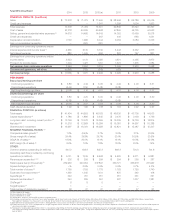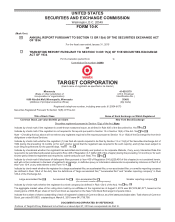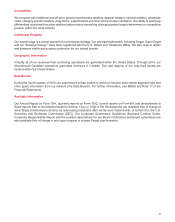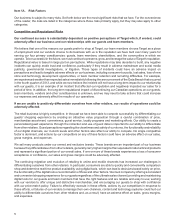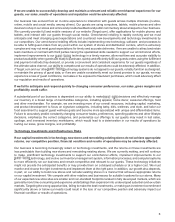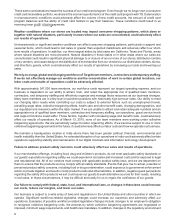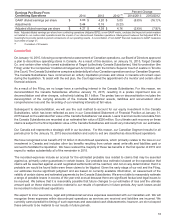Target 2014 Annual Report Download - page 14
Download and view the complete annual report
Please find page 14 of the 2014 Target annual report below. You can navigate through the pages in the report by either clicking on the pages listed below, or by using the keyword search tool below to find specific information within the annual report.
These same considerations impact the success of our credit card program. Even though we no longer own a consumer
credit card receivables portfolio, we share in the economic performance of the credit card program with TD. Deterioration
in macroeconomic conditions could adversely affect the volume of new credit accounts, the amount of credit card
program balances and the ability of credit card holders to pay their balances. These conditions could result in us
receiving lower payments.
Weather conditions where our stores are located may impact consumer shopping patterns, which alone or
together with natural disasters, particularly in areas where our sales are concentrated, could adversely affect
our results of operations.
Uncharacteristic or significant weather conditions can affect consumer shopping patterns, particularly in apparel and
seasonal items, which could lead to lost sales or greater than expected markdowns and adversely affect our short-
term results of operations. In addition, our three largest states by total sales are California, Texas and Florida, areas
where natural disasters are more prevalent. Natural disasters in those states or in other areas where our sales are
concentrated could result in significant physical damage to or closure of one or more of our stores, distribution centers
or key vendors, and cause delays in the distribution of merchandise from our vendors to our distribution centers, stores,
and directly to guests, which could adversely affect our results of operations by increasing our costs and lowering our
sales.
We rely on a large, global and changing workforce of Target team members, contractors and temporary staffing.
If we do not effectively manage our workforce and the concentration of work in certain global locations, our
labor costs and results of operations could be adversely affected.
With approximately 347,000 team members, our workforce costs represent our largest operating expense, and our
business is dependent on our ability to attract, train, and retain the appropriate mix of qualified team members,
contractors, and temporary staffing and effectively organize and manage those resources as our business changes.
Many team members are in entry-level or part-time positions with historically high turnover rates. Our ability to meet
our changing labor needs while controlling our costs is subject to external factors such as unemployment levels,
prevailing wage rates, collective bargaining efforts, health care and other benefit costs, changing demographics, and
our reputation and relevance within the labor market. If we are unable to attract and retain adequate numbers and an
appropriate mix of qualified team members, contractors and temporary staffing, our operations, guest service levels
and support functions could suffer. Those factors, together with increasing wage and benefit costs, could adversely
affect our results of operations. As of March 13, 2015, none of our team members were working under collective
bargaining agreements. We are periodically subject to labor organizing efforts. If we become subject to one or more
collective bargaining agreements in the future, it could adversely affect our labor costs and how we operate our business.
We maintain a headquarters location in India where there has been greater political, financial, environmental and
health instability than the United States. An extended disruption of our operations in India could adversely affect certain
operations supporting stability and maintenance of our digital channels and information technology development.
Failure to address product safety concerns could adversely affect our sales and results of operations.
If our merchandise offerings, including food, drug and children’s products, do not meet applicable safety standards or
our guests’ expectations regarding safety, we could experience lost sales and increased costs and be exposed to legal
and reputational risk. All of our vendors must comply with applicable product safety laws, and we are dependent on
them to ensure that the products we buy comply with all safety standards. Events that give rise to actual, potential or
perceived product safety concerns, including food or drug contamination, could expose us to government enforcement
action or private litigation and result in costly product recalls and other liabilities. In addition, negative guest perceptions
regarding the safety of the products we sell could cause our guests to seek alternative sources for their needs, resulting
in lost sales. In those circumstances, it may be difficult and costly for us to regain the confidence of our guests.
Our failure to comply with federal, state, local, and international laws, or changes in these laws could increase
our costs, reduce our margins, and lower our sales.
Our business is subject to a wide array of laws and regulations in the United States and other countries in which we
operate. Significant workforce-related legislative changes could increase our expenses and adversely affect our
operations. Examples of possible workforce-related legislative changes include changes to an employer's obligation
to recognize collective bargaining units, the process by which collective bargaining agreements are negotiated or
imposed, minimum wage requirements, and health care mandates. In addition, changes in the regulatory environment
9


